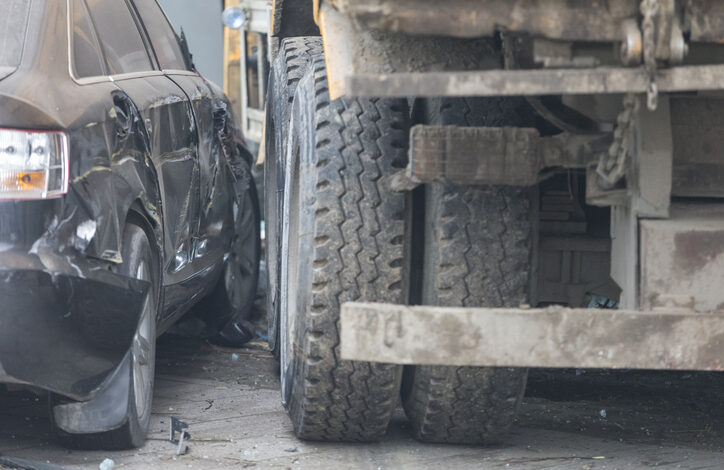Driving alongside large trucks can be daunting, especially in heavily trafficked areas like Los Angeles and San Francisco. One of the most common and dangerous causes of truck accidents in California involves blind spots—areas around a truck where the driver’s view is limited or completely obstructed. These blind spot truck accidents are often catastrophic due to the size and weight of the vehicles involved. This post will explain why blind spot truck accidents happen and what you can do to avoid them.
Why Blind Spot Truck Accidents Happen
Blind spots, also known as “No-Zones”, are large areas around a truck where the driver cannot see other vehicles through mirrors or windows. These areas are significantly larger than those of passenger vehicles, increasing the risk of accidents. Here are the key reasons why blind spot truck accidents occur:
Size and Length of Trucks
Trucks can be up to 70 feet long and weigh up to 80,000 pounds, creating larger blind spots on all sides. The most dangerous zones are directly in front, behind, and along both sides of the truck—especially the right side, which is the largest.Driver Visibility Limitations
Truck drivers sit much higher than the average motorist, which creates visibility challenges. Even with multiple mirrors, they cannot see vehicles close to their sides or rear. Drivers in small cars or motorcycles are particularly vulnerable because they can “disappear” into these blind spots.Lane Changes and Turns
Blind spot accidents frequently occur during lane changes or turns. When truck drivers attempt to change lanes or make wide turns, they may not see smaller vehicles traveling next to them. This is particularly dangerous on crowded highways, such as Interstate 5 in California, where heavy traffic can limit a truck driver’s reaction time.Driver Fatigue
Long hours on the road can lead to driver fatigue, reducing a truck driver’s ability to stay alert and check blind spots thoroughly before making a maneuver. Fatigued drivers are less likely to scan the road for other vehicles, leading to potentially fatal accidents.Distracted Driving
Like any other driver, truck drivers can become distracted by mobile devices, food, or GPS systems. A moment of distraction can prevent them from properly checking their blind spots before making a move, increasing the likelihood of a collision.
Common Injuries in Blind Spot Truck Accidents
Because of the size and weight of commercial trucks, blind spot accidents can lead to severe injuries, including:
- Traumatic Brain Injuries (TBI): The impact of a truck colliding with a smaller vehicle can cause concussions or more severe brain injuries.
- Spinal Cord Injuries: These can result in partial or total paralysis, often requiring long-term medical care and rehabilitation.
- Broken Bones and Fractures: The force of the collision can cause broken bones, which may take months to heal.
- Internal Injuries: Internal bleeding and organ damage are common in serious accidents, requiring immediate medical attention.
- Whiplash and Neck Injuries: Even at lower speeds, the sudden impact of a sideswipe or rear-end truck accident can cause whiplash, which may lead to chronic pain.
Avoiding Blind Spot Truck Accidents
While you can’t control how truck drivers operate, you can take certain precautions to minimize your risk of being involved in a blind spot accident. Here’s what you can do:
Stay Out of Blind Spots
The most important rule is to stay out of the truck’s blind spots whenever possible. Remember, if you can’t see the truck driver’s face in their mirrors, they likely can’t see you. Avoid lingering beside a truck, especially on the right side.Pass Quickly and Safely
When overtaking a truck, pass quickly and don’t linger in the blind spot. Always pass on the left side, where the driver’s blind spot is smaller, and make sure you’re far enough ahead before moving back into the lane.Maintain a Safe Distance
Keep a safe distance both in front of and behind the truck. Trucks take much longer to stop than passenger vehicles, so tailgating puts you at risk of a rear-end collision if the truck needs to brake suddenly. Similarly, cutting in front of a truck can lead to a rear-end collision if the driver can’t stop in time.Use Your Signals
Always use your turn signals early when driving near a truck. This gives the truck driver enough time to notice you and adjust their driving accordingly. Be predictable and avoid making sudden lane changes when driving near large trucks.Be Cautious at Intersections
At intersections, be aware that trucks need extra space to make turns. Never try to squeeze in between a turning truck and the curb, as the truck may swing wide and collide with your vehicle. Give them plenty of space to complete their turn safely.Stay Alert on Highways
Highways in California, like Highway 101 and I-405, are known for heavy truck traffic. Stay alert, especially in areas where trucks frequently change lanes or merge. Pay attention to brake lights, turn signals, and other indicators of a truck’s movements.
Understanding Your Legal Options and How Accident Attorneys Can Help
If you’ve been injured in a blind spot truck accident in California, you may be entitled to compensation for medical expenses, lost wages, pain and suffering, and other damages. However, determining liability in these types of accidents can be challenging, as multiple factors and parties may be involved.
At Weiss Attorneys, we understand how overwhelming the aftermath of a truck accident can be. Our experienced legal team is committed to helping you recover the compensation you deserve. We’ll handle all aspects of your claim—from determining liability and negotiating with insurance companies to representing you in court if necessary. Whether your accident occurred in Los Angeles, San Francisco, or anywhere else in California, we’re here to help you every step of the way.
Contact Weiss Attorneys today for a free consultation, and let us fight to get you the justice and recovery you need.









